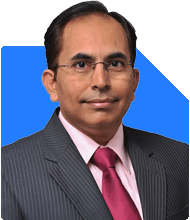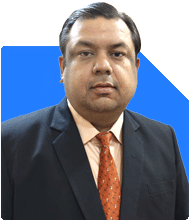Ramalingam Kalirajan |9255 Answers |Ask -Follow
Mutual Funds, Financial Planning Expert - Answered on Jun 05, 2025
He has an MBA in finance from the University of Madras and is a certified financial planner.
He is the director and chief financial planner at Holistic Investment, a Chennai-based firm that offers financial planning and wealth management advice.... more

HELLO SIR, My salary is 1.5 lakh after the PF deduction it gets 1.35 lakh. In which house rent is 20k and other house expenses total is 65000. The remaining my salary amount is 70k I have 5 Active loans of total 15 lakhs Every month the total EMI of this 5 loans are about 92k. I have 7 active credit cards , the total outstanding amount is 7.5 lakh. I am currently paying minimum EMI amount for 6 credit card. As of I have a lot of shortage, so I take that amount back after paying it. And another one card I am paying emi amount of 6k without taking it back. And I have a outstanding of 9 lakh in finance from 3 person, they require interest in every month until I pay them fully. From each of them I have taken 3 lakhs so total is 9 lakh. The required interest every month is 29k total. I also have to give my friends 1 lakh total. So I have total outstanding amount of around 32 lakhs. So I have to pay the loan emi amount of 92k + the finance Interest amount 29k + the credit card minimum bill interest and charges without deducting the original amount of credit, as I am taking it back to pay the others is around 25k. My salary = 1.35 lakh -65k (house expenses)- 92k - 29k - 25k So total shortage is around -80k to pay the monthly payment. I have asked my family to help, but nobody is willing to help me. What to do sir . Please help as soon as possible.
You earn Rs. 1.35 lakh per month. That’s your only inflow.
Your monthly expenses are Rs. 65,000. That’s almost half your income.
Your total debt outstanding is Rs. 32 lakh. That includes loans, cards, and private borrowings.
Monthly liability payments exceed Rs. 1.46 lakh. This includes EMIs, card payments, and finance interest.
You are facing a monthly shortfall of around Rs. 80,000. This is alarming.
Family is not supporting. That adds emotional burden too.
You are stuck in a debt trap. A bold, structured action plan is needed.
Step-by-Step Emergency Strategy
1. Classify the Debt
Break your debt into 3 groups.
Group A: Personal loans and formal EMIs – Rs. 15 lakh
Group B: Credit cards – Rs. 7.5 lakh
Group C: Private borrowings from individuals – Rs. 9 lakh
You are paying interest without reducing the principal in Group B and C.
This structure will help in planning repayment in right order.
2. Immediately Stop Using Credit Cards
Using credit again after paying minimum is worsening your debt.
This creates a loop of fresh interest every month.
Cut cards physically. Stop all discretionary expenses.
Do not reuse paid limits. Consider it locked.
3. Consolidate Your Debt into One Loan
Approach your salary bank for a personal loan.
Target amount: Rs. 20 to 25 lakh.
Use this to settle credit cards and private borrowings.
Interest on personal loan is lower than card finance or private loan.
Ask for 5 years tenure to reduce EMI.
4. Reduce Monthly Fixed Outflow
Ask bank for loan restructuring on existing loans.
Seek longer tenure to lower EMI burden.
Include private lenders in mutual settlement discussions.
Negotiate lump-sum payment to reduce principal.
Inform them you are unable to sustain interest-only model.
5. Approach a Certified Credit Counsellor
Contact a certified credit counsellor or a bank-supported DSA.
They help structure repayments officially.
They also negotiate with lenders and credit card companies.
No new credit should be applied now.
6. Use Emergency Measures to Raise Funds
Sell off any non-essential assets.
Sell gold jewellery or vehicle if possible.
Avoid emotional attachment now.
Temporary sacrifices now will give permanent relief.
Explore a part-time income source. Weekend or remote work.
Wife or other family members can explore earning options.
7. Evaluate Household Expenses
Reduce monthly expenses from Rs. 65,000 to Rs. 45,000.
Cut cable, OTT, dine-out, online orders, travel.
Every Rs. 1,000 saved is Rs. 1,000 earned now.
8. Build a Negotiation Plan for Private Loans
The Rs. 9 lakh loan is costing you Rs. 29,000 interest per month.
That’s Rs. 3.5 lakh per year just interest.
Offer a part payment of Rs. 3 lakh and ask them to close 1 account.
Keep record of all these settlements in writing.
Do not pay cash. Transfer digitally only.
9. Create a Weekly Cash Flow Plan
Track every rupee inflow and outflow.
Map your bank statement weekly.
Write down on paper.
Keep 2 columns: Essentials and Non-Essentials.
Non-essentials must be zero for next 12 months.
10. Do Not Panic or Go for Loan Apps
Avoid taking loans from unregulated apps or quick finance agents.
These will trap you in harassment and high penalty.
Trust only bank or RBI-licensed lenders.
Long-Term Financial Clean-Up Plan
1. After Consolidation, Start Credit Repair
Start repaying consolidated EMI on time for 12 months.
This will slowly improve CIBIL score.
Do not delay even a single EMI.
2. Slowly Close All Old Credit Cards
Once balance is zero, request card closure letter.
Don’t keep unused cards active.
Keep only one card for emergencies.
3. Rebuild Savings Slowly
Once debt stress is eased, start saving Rs. 5,000 monthly.
Put this in a liquid mutual fund through a regular plan.
Use only MFD services and not direct.
Certified financial planner can assist in fund tracking.
4. Stop Relying on Borrowings in Future
Build emergency fund of Rs. 1 lakh after debt resolution.
Avoid taking new loans unless necessary.
Learn budgeting monthly. Stay disciplined.
5. Create a Debt-Free Goal Timeline
Give yourself 5 years to become completely debt-free.
Celebrate each closed loan as a success.
Keep financial goal posters at home.
Remind yourself why you’re doing it.
Final Insights
You are under extreme financial pressure.
But you are taking the right step by asking help.
Take one step at a time.
Cut down lifestyle, negotiate settlements, raise income.
Consolidate high interest debts into one loan.
Rebuild savings only after all EMIs are managed.
Protect mental health during this tough phase.
Take support from your spouse if possible.
A 100% financial turnaround is possible in 3 to 5 years.
Focus on survival today, stability tomorrow and savings later.
Best Regards,
K. Ramalingam, MBA, CFP,
Chief Financial Planner,
www.holisticinvestment.in
https://www.youtube.com/@HolisticInvestment
You may like to see similar questions and answers below
Ramalingam Kalirajan |9255 Answers |Ask -Follow
Mutual Funds, Financial Planning Expert - Answered on Jun 04, 2024
Ramalingam Kalirajan |9255 Answers |Ask -Follow
Mutual Funds, Financial Planning Expert - Answered on May 15, 2025
Janak Patel |53 Answers |Ask -Follow
MF, PF Expert - Answered on May 26, 2025
Ramalingam Kalirajan |9255 Answers |Ask -Follow
Mutual Funds, Financial Planning Expert - Answered on May 29, 2025
Radheshyam Zanwar |4292 Answers |Ask -Follow
MHT-CET, IIT-JEE, NEET-UG Expert - Answered on Jun 28, 2025
Yogendra Arora |36 Answers |Ask -Follow
Tax Expert - Answered on Jun 28, 2025
Yogendra Arora |36 Answers |Ask -Follow
Tax Expert - Answered on Jun 28, 2025
Radheshyam Zanwar |4292 Answers |Ask -Follow
MHT-CET, IIT-JEE, NEET-UG Expert - Answered on Jun 28, 2025
Radheshyam Zanwar |4292 Answers |Ask -Follow
MHT-CET, IIT-JEE, NEET-UG Expert - Answered on Jun 28, 2025
Dr Nagarajan J S K |1432 Answers |Ask -Follow
NEET, Medical, Pharmacy Careers - Answered on Jun 28, 2025
Dr Nagarajan J S K |1432 Answers |Ask -Follow
NEET, Medical, Pharmacy Careers - Answered on Jun 28, 2025
Dr Nagarajan J S K |1432 Answers |Ask -Follow
NEET, Medical, Pharmacy Careers - Answered on Jun 28, 2025
Dr Nagarajan J S K |1432 Answers |Ask -Follow
NEET, Medical, Pharmacy Careers - Answered on Jun 28, 2025
Dr Nagarajan J S K |1432 Answers |Ask -Follow
NEET, Medical, Pharmacy Careers - Answered on Jun 28, 2025






















